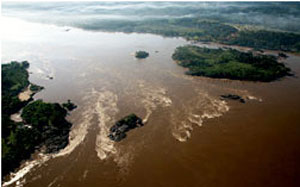An ambitious 2,500-kilometer-long “power highway” that will stretch across the breadth of Brazil has taken an important step forward with the awarding of a major subcontract to provide equipment and initial construction of the power line.

In late July, Zurich-based ABB snagged the $540-million contract to build a 600-kV portion of a power line that will connect two massive hydroelectric projects under construction on the Madeira River in the Brazilian Amazon Basin to the urban center of São Paulo.
The job was awarded to two ABB companies within the Seville, Spain-based Abengoa Group: Spain’s Inabensa and Brazil’s Abengoa Construcao Brazil. As part of the work, ABB also will deliver a pair of 3,150-MW high-voltage direct-current converter stations along with an 800-MW high-voltage direct-current station.
In December, Brazil’s national power regulator, Agência Nacional de Energia Elétrica (ANEEL), awarded almost $3.6 billion in contracts for seven sections of the transmission line. A total of 15 Brazilian firms and one from Spain vied for the contracts, the most expensive valued at almost $70 million. According to the regulatory agency, the line will be ready to transport electricity by January 2012.
The transmission line became a priority as construction began in earnest over the past three months on a pair of run-of-the-river dams on the Madiera River. The $10.5-billion effort to build the San Antonio and Jirau dams will contribute more than 6,000 MW to satisfy Brazil’s growing electricity demands. It is the largest hydroelectric scheme being developed in the hemisphere. When completed in 2016, the dams will account for approximately 8% of the country’s total electricity generation.
The 3,150-MW San Antonio dam is being built near the town of Porto Velho by Consoricio Madeira Energia, a consortium led by Brazilian construction firm Odebrecht allied with two major power utility companies.
The 3,330-MW Jirau dam, located between Porto Velho and the Bolivian border, was awarded to consortium Consorcio Energia Sustentável do Brasil (CESB), led by France’s Suez with engineering firm Camargo Corrêa and two Brazilian power companies.
With the awarding of the transmission-line project, Brazil’s power regulation agency now can move forward with marketing the energy to be produced by the two hydroelectric facilities. San Antonio is scheduled to begin producing power in 2012 and Jirau in 2013.
The dams will be the largest run-of-the-river hydroelectric projects ever attempted. San Antonio Dam will rise 30 meters and stretch 2,550 m to impound the river just a few miles south of Porto Vehlo, capital of Rondônia, which has a population of 330,000 people. The dam has multiple components: two 300-m-long concrete structures, each housing 12 turbine generators; the main spillway; a 430-m-long concrete section housing 20 turbines, flanked by two roller-compacted concrete structures, followed by an auxiliary spillway and a small earthfill, on the right bank.
Jirau’s main rockfill dam will be 35 m high and 550 m long, flanked by two compacted earthen dikes, one 930 m long and the other 1,140 m long. It will impound a 258-sq-mile reservoir. Turbine-generaters will be located in powerhouses on each bank.
Officials say the bulb turbines required to generate power for the two dams will be the largest of their type ever built, requiring 8-meter-dia. rotors that each produce 75 MW of power. Last November, Andritz Hydro snagged a $318-million contract to produce 12 of the 44 bulb turbines for the San Antonio project. Alstom Hydro is contributing another 19 turbines for the Jirau dam.
Brazil has prioritized big-ticket hydroelectric projects over the past several years to handle rapidly growing energy demand in the South American nation. The last major hydroelectric project undertaken by the Brazilian government was in 1994. Concerns about an energy shortage prompted Brazilian officials to fast-track the Madeira projects after years of delay.
Both projects were green-lighted by the Brazilian Institute of the Environment and Renewable National Resources (IBAMA) in late 2007, and contracts were awarded in a tender conducted shortly afterward. Both projects began preliminary work but could not begin actual dam construction until IBAMA issued a second license outlining environmental restrictions for construction as well as compensation to offset the impact of the projects.
The San Antonio project received its approval last year but, work on Jirau Dam was suspended in late May due to the expiration of a preliminary license. IBAMA quickly issued the final construction license. The regulatory agency imposed 54 conditions that covered a battery of social and environmental restrictions.
The two projects have come under significant fire by both environmentalists as well as representatives of native peoples inhabiting the Madiera River Basin. Various environmental groups have fought the legality of the ANEEL license.
CESB has incurred fines for cutting rainforest outside of its concession as well as for initiating primary construction work before the license was obtained. Moreover, local farmers have been angry that work on the projects has impeded logging and cattle ranching. In July, work on the Jirau project was held up for several days by farmers who blocked access to the construction site in protest.


Post a comment to this article
Report Abusive Comment